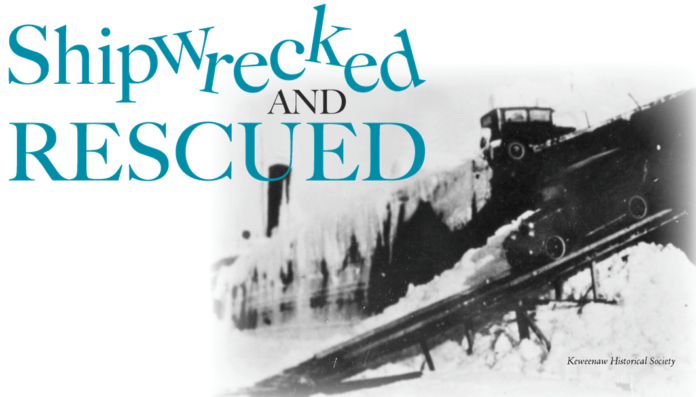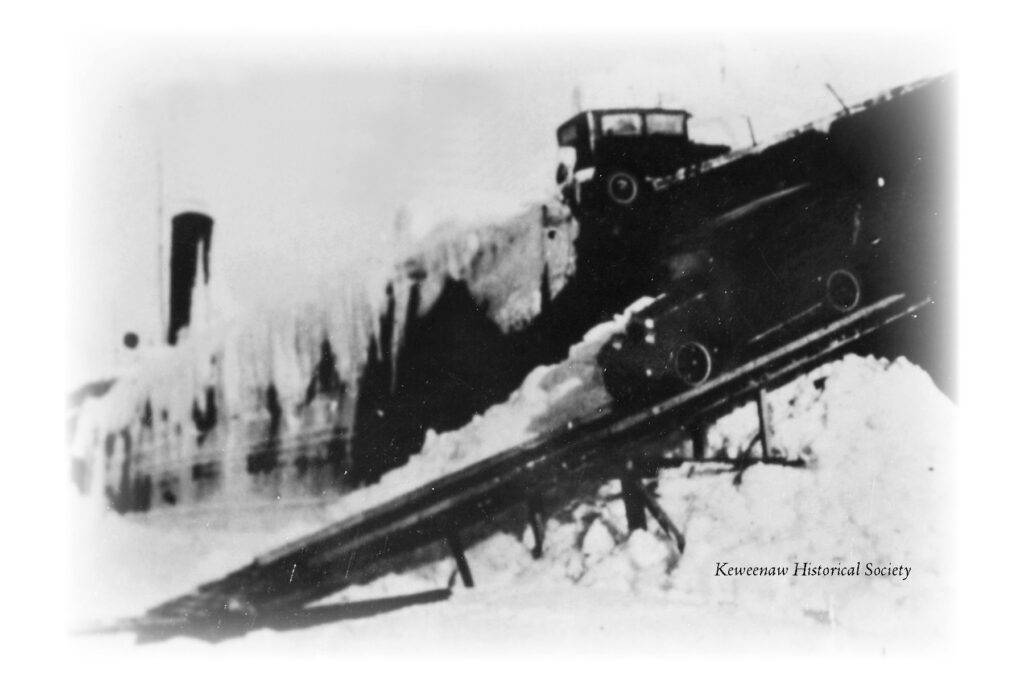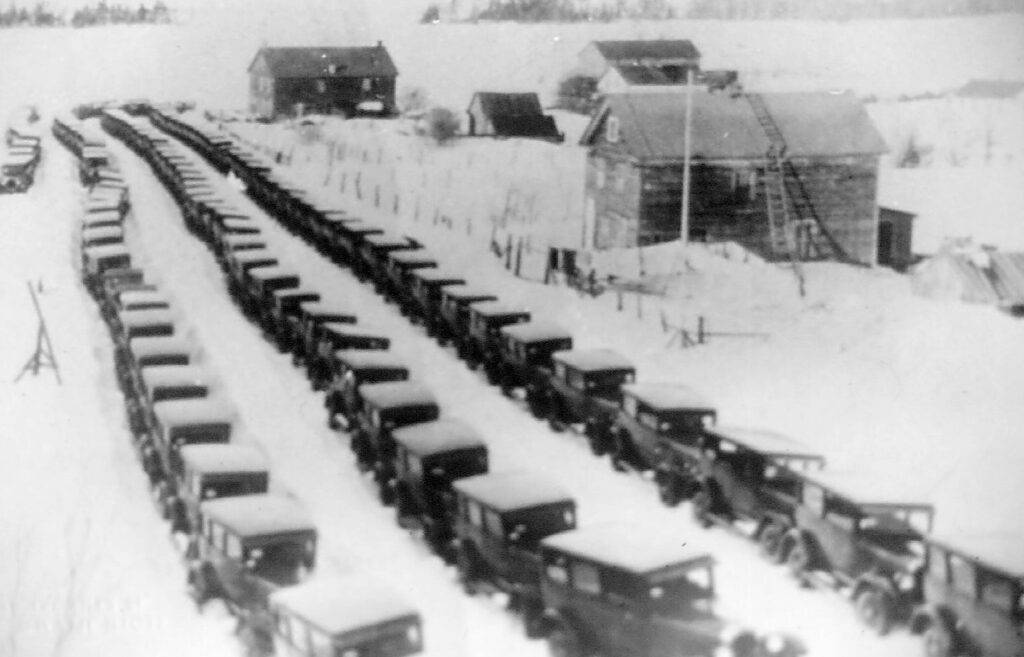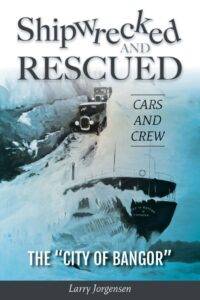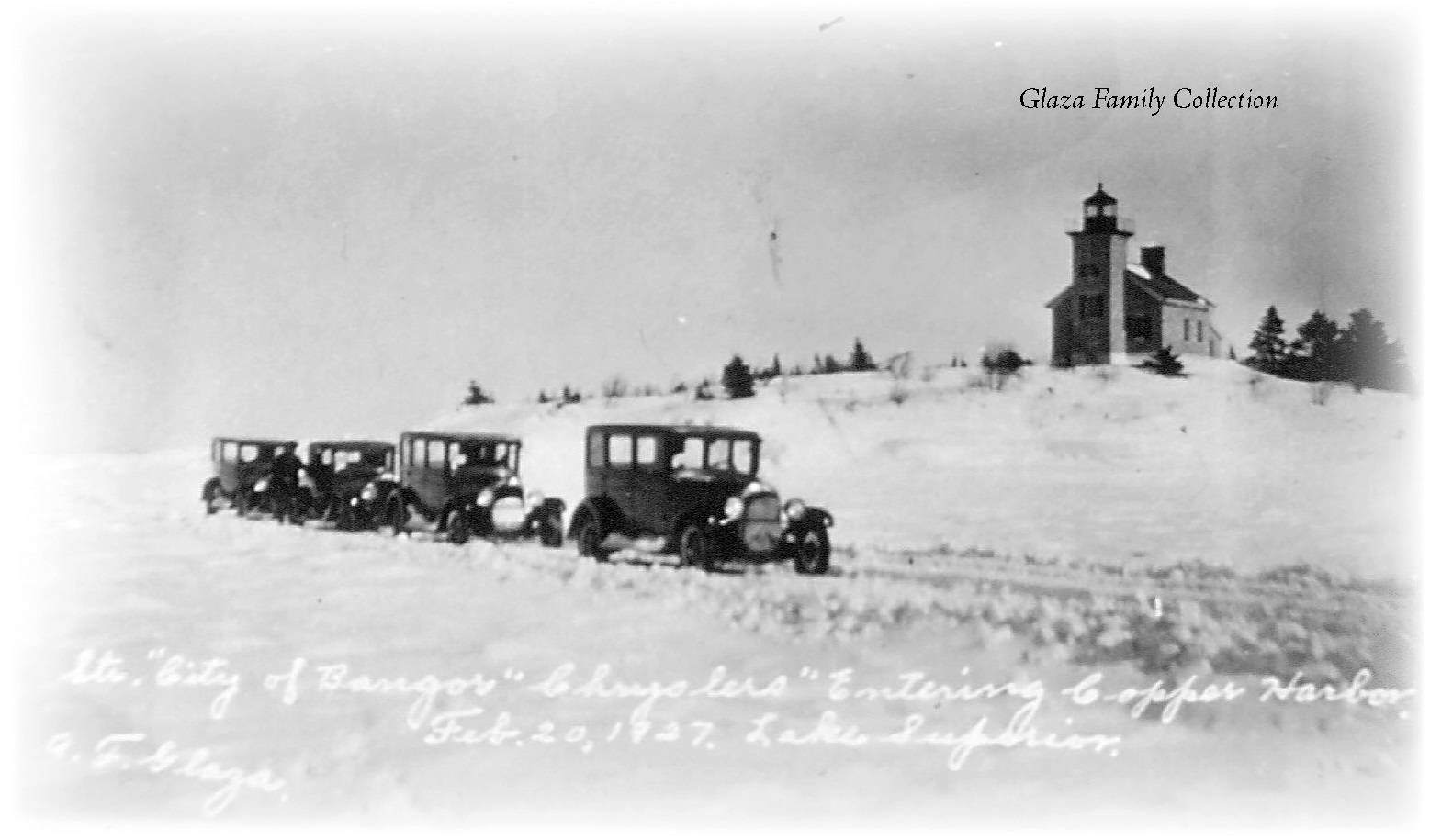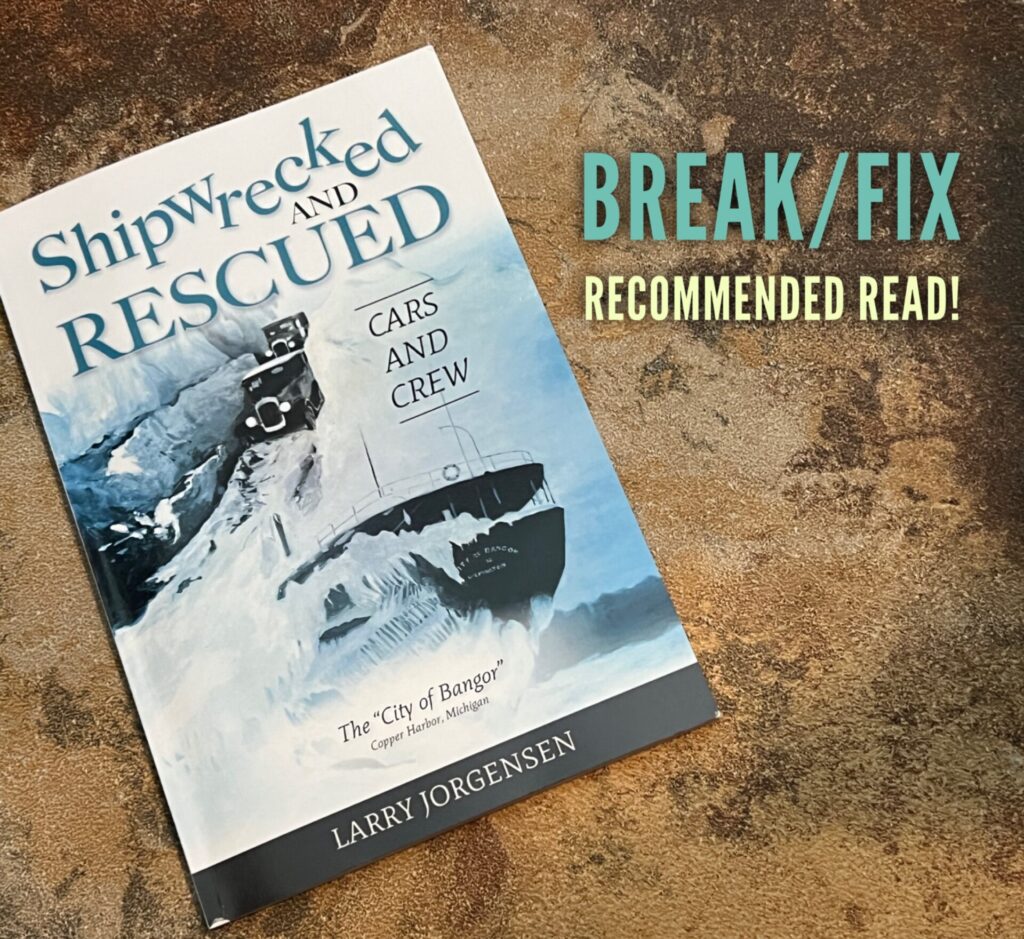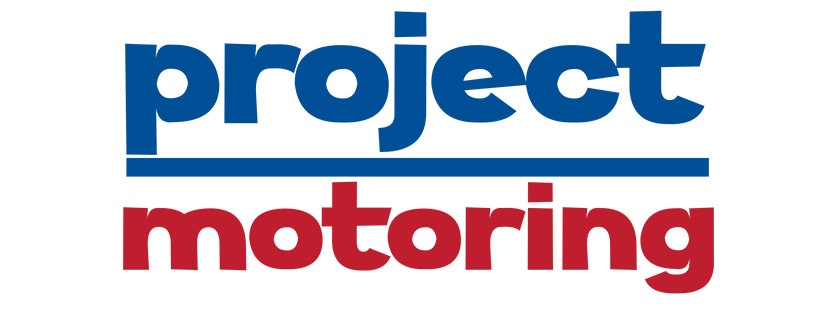Some might argue that treasure hunting is a thing of the past. That, we’ve discovered, plotted, surveyed, and satellite mapped all there is to discover on this planet. But in reality, treasure hunting comes in all sorts of different forms, consider American Pickers on History Channel, aren’t they searching for treasure? And with the rise in popularity of shows like The Curse of Oak Island, Skinwalker Ranch and Lost Gold of World War II it would seem that treasure hunting is still alive and well.
But there is another facet of searching that’s especially intriguing (to me) and has been brought to the surface as recently as last year. Take for instance, the discovery of Ernest Shackleton’s lost vessel The Endurance.
You’re probably wondering what all this has to do with cars? As we reported on Drive Thru Episode #20 (in March of 2022); there was a shipwreck containing millions of dollars of high end vehicles like Porsches, Lamborghinis, Bugattis and more. But this isn’t the first time vehicles have been lost at sea. Author and explorer Larry Jorgensen joins us tonight to talk about a little known shipwreck that cost Detroit hundreds of vehicles!
Spotlight
Larry Jorgensen - Author for Shipwrecked & Rescued

The Story of a Lake Superior shipwreck and two unbelievable but true successful rescues

Contact: Larry Jorgensen at glmanagement40@gmail.com | 337-591-1937 | Visit Online!![]()
Notes
- Tell us more about how all this came about? How did you discover the shipwreck of ‘The City of Bangor’?
- According to experts, there’s been over 6000 shipwrecks in the great lakes region? Why so many? Is there some common thread (or time period)?
- How (and when) did the ‘The City of Bangor’ go down?
- What’s the significance of this loss (esp. to Chrysler)
- Ships aren’t always just carrying a payload of one thing; were there other items of significance being transported alongside the vehicles?
- How many vehicles were lost? Where were these vehicles headed to? Who was supposed to receive them? What types/models?
- Is there a registry of current owners/locations of the vehicles from the ship? How many still exist today?
and much, much more!
Transcript
[00:00:00] Hello and welcome to the Gran Touring Motor Sports Podcast Break Fix, where we’re always fixing the break into something motor sports.
Some might argue that treasure hunting is a thing of the past that we’ve discovered, plotted, surveyed, and satellite mapped. All there is to discover on this planet, but in reality, treasure hunting comes in all sorts of different forms. Consider for a moment, American Pickers on History Channel. Aren’t they searching for treasure?
And with the rise in popularity of shows like The Curse of Oak Island Skin Walker Ranch, and Lost Gold of World War ii, it would seem that treasure hunting is still alive and well. There is another facet of searching. That’s especially intriguing to me and has been brought to the surface as recently as last year.
Take for instance, the discovery of Ernest Shackleton’s lost vessel of the endurance. You’re right, Don, and our audience is probably wondering what this. Actually has to do with cars. [00:01:00] As we reported on drive through episode number 20, March of 2022, there was a shipwreck containing millions of dollars of high-end vehicles like Porsche’s, Lamborghini, Bugattis, and more.
And this isn’t the first time vehicles have been lost at sea. And with us tonight is author and explorer, Larry Jorgenson, who joins us to talk about a little known shipwreck that costs Detroit hundreds of vehicles. So welcome to Break Fix, Larry. Thank you. It’s a pleasure to be here and talk about one of my favorite subjects, which is, uh, shipwrecks in upper Michigan.
Well, normally we would ask folks about their motorsports or vehicle enthusiast origin story, but in this case, I think we need to dive right in, pun intended into the beginning of this story. So from what we understand, this all came about because a single photograph set it into motion. Right. I was visiting up in Copper Harbor, Michigan.
That’s way on the tip of the Cuban Peninsula, lake Superior. , [00:02:00] and while I was up there, I picked up a little tourist brochure. It had a picture and about a paragraph and a half about a shipwreck. The more I looked at it, the more I thought, this is an amazing story, and I started doing research on it. You have a personal tie to this particular area of Michigan as well, so what drew you again to that photograph, to that pamphlet?
What were you doing in the area? That drew you back into this whole story way back when I was, as they say, a news dog for a television station in Green Bay. That was my first introduction to the Upper Peninsula. So much history up there. I went up because at that time there was a strike of copper miners going on that ultimately led to the closure of all the copper mines in that.
So I was covering that as a news dog. I was up interviewing people and became fascinated with the Peninsula of Upper Michigan. After that, I would go up for other stories. After the strike issue was [00:03:00] resolved, I just made it a point that if there was something going on, In upper Michigan, I wanted to be the guy up there to cover it.
Fortunately, at some point in my career at the station in Green Bay, I got to be the news director, so it was easy to say, I’m gonna take care of this one. I’m going to upper Michigan. We covered a lot of stories up there. We covered the last run of the passenger train that went from, uh, Milwaukee to the upper peninsula.
We, we were on that train. We covered lots and lots of important stories. Really fell in love with the area. And after I got out of television, radio news, because I’m originally from Northern Wisconsin, it was easy for me to get access back up there for just for fun, for snowmobiling back in the late sixties, early seventies.
When, what is that? That’s a snowmobile, you know? So I’ve got a lot of history with the upper P. Moving into that regional situation that you’ve got there, you’ve got a personal touch, you’ve got a personal connection to the region. Captain William [00:04:00] Mackin, he was the one in charge of the city of banger ship.
Does he have any family still around to tell the stories that he told? No, he doesn’t long since gone. He stayed with Nicholson after the accident. And then finally as Nicholson changed hands, new owners came. He was moved on, you know, and he became the captain of the ship that carries cars to the Mackinac Island, hired by the state of Michigan, and that was his last job.
And he did that for many years. I have been able to talk with the granddaughter of the family that actually save. The crew after they were finally rescued from the boat and almost froze to death before they were finally brought into civilization. A lot of ’em were badly, badly frostbitten. It’s a wonder they didn’t lose limbs.
Those are the kind of people I could find to talk to. Some of the pictures came from the daughter of the captain [00:05:00] of. Coast Guard rescue boat. He was, besides being the captain of the rescue boat, he was an amateur photographer. What a man to have on the spot. Right? And there are some fantastic photos thanks to Captain Gza and his daughter who passed the photos on down and we got access to them.
It made the whole book to have access to those photos. So there was no loss of life with the city of banger accident, is that right? No loss of life. And how many men were on board, or how many people were on board that ship? 23 after they hit the reef, the way they got to shore is they were able to chop a lifeboat free from the ice that already accumulated, and they would take the lifeboat and you know, back and forth until they got everybody from the ship on.
Then the problem is, now what do we do? Some of these guys, you know, were dressed like they had just come from Detroit. Were going to a party or something. I mean, he had loafers on and you know, they were not prepared for the [00:06:00] challenge they were about to get into of four feet of snow and near zero temperatures.
To make matters worse, there’s no communications, no one. The ship has crashed. Basically, what makes it an amazing story is the ship was carrying 240, brand new, brand new as in 1927, Chryslers from Detroit when it hit a reef and the the ship was totaled. When you look at the maps of shipwrecks in the Great Lakes, it’s not.
Nowhere and there’s been 6,000 shipwrecks on the Great Lakes. This one, for whatever reason is, I don’t wanna say it’s a secret, but it just sort of tucked away. Few people knew about it, but nobody really got excited about it. Here it is. A shipwreck where the cars were actually rescued. You know, in those days it was not uncommon for those big steamers to carry autos.
You didn’t have good roads and big trucks [00:07:00] hauling autos around. So a good way to transport new autos from Detroit. To wherever as long as you could reach it. On The Great Lakes was on boats, big steamers. So was that a more effective than by rail as well, or did they kind of go back and forth? Depending.
They had rail, but they found out that you could get a lot of cars on a big steamer. And water rates are always, Less than land greats. If you could get there with the ship, you were gonna save money in the process of delivering that car. And so they used it wherever they could. So you mentioned something really interesting, 6,000 shipwrecks on the Great Lakes.
Why so many? Is there a common thread here, even with the ship that we’re gonna be talking about in more detail? The city of Banger, it’s called. What’s the Deal? Why so many Ship? You take the history of the Great Lake just goes back quite a while and you had a, a lot of in the early years, poorly constructed ships, bad weather, [00:08:00] no communications, no weather warnings that hey, you know, such as US Storm is coming.
So there was a lot of ’em in the very early years and the people that study. Say, yeah, there’s 6,000 that have been recorded, and there’s been people that have said, and there’s probably a lot more that were never even recorded. Now. Lake Superior is nasty. It is probably the one that gets the most in the way of shipwrecks because the lake is so big and so deep.
Yeah, I mean, look at the wreck. The Edmund Fitzgerald is a good example. That hasn’t been that long in. Basically, it got into such a storm that the Edmund Fitzgerald was curing Tite iron ore, and it was heavy. The waves were so big on Lake Superior. One wave lifted up the front of the boat, another wave lifted up the rear of the boat and the center.
where the cargo is, was suspended with no support and the boat basically broke in [00:09:00] half. I’ve talked to a diver who has gone down to it and he said, absolutely, that’s what happened. The ship was broken in half and it is on the bottom of Lake Superior. Like most shipwrecks are the bottom of lakes, like Lake Superior.
It’s preserved and the water will preserve it forever. How many ships are still at the bottom of Lake Superior? Lots of the, I don’t know if anybody’s ever recorded that, but you talk to the, the divers, the Great Lakes are one of their favorite places to dive cuz they can go down to and see these ships that are well preserved.
It’s cold freshwater that preserves. . And every once in a while, you know, you’ll see a story where they have found another record. We’re able to document it, what it was and so forth. And occasionally even one will sort of, I don’t wanna say surface, but the water will change such that part of it will actually be seen on shore.
Those are not big ships, by the way. Those are. Yachts you might call ’em, that went down [00:10:00] in the very early years of traveling on the Great Lakes. There’s a lot out there. Lake Superior is pretty rough. Is it a geological phenomena, a weather phenomena? I mean, lakes generally, they have their waves in their moments, but they’re not usually rough like the ocean.
I’ve been Lake Superior when it’s been just absolutely almost like a. Been quiet, but you get a good weather system come in and that lake gets vicious. It’s so big and so deep. The weather systems can just really whip up a big lake storm, and that’s what happened to the banger. Keep in mind that the ship was not originally intended to be a auto carrier.
It was originally intended to. Iron or it was intended to haul grain. This is a basic carrier on the Great Lakes. Well, the Nicholson Transport Company in Detroit got into hauling automobiles. At one point, they had like 12 ships that their task was to haul automobiles. So it took [00:11:00] remodeling, if you want to call it that, of the ship.
They would put in a good, solid lower. Put in an elevator on the upper deck, they would completely level it. Openings where cargo would normally be brought in. Were gone completely redesigned to accommodate automobiles. And Nicholson was one of the biggest, at the time of the banger, they had 12 ships. They had converted.
Into auto carriers. One of them, in fact, was built in the same shipyard, like a half a year after the, uh, banger. The two ships were actually owned by the same person, the same group of people that, uh, financed building them. And they had them built to be regular cargo haulers on the Great Lakes. They sold them to Nicholson, and that’s how they became auto haulers.
And to put this in perspective for our listeners, you have to remember, At the time, we’re talking the mid to late 1920s. An auto carrying ship is a relatively new thing. It’s a new [00:12:00] thing. And if it had been previously used for iron ore or other things, the problem that they ran into with the banger, and I presume others, they would ride.
Higher in the water than the boat was designed for when it was designed to be an or carrier. Consequently, when it got into a storm like the banger did, it would really get tossed around and that’s what happened. It got tossed so bad, captain lost the rudder. They lost complete control of it, and that’s how it ended up crashing on this reef off of the copper Harbor.
To add to the problem, captain Macon, bless his. He thought that they had sailed past Copper Harbor, that they were west of Copper Harbor. He made that determination because he thought he saw a well-known mountain that is at Copper Harbor called Broccoli Mountain. Well, the fact of the matter is they were still east of Copper Harbor in Lake Superior.
So the guys finally get off the boat. They get to shore, they say, [00:13:00] If we can get to Copper Harbor, there’s hope at that time. It’s a little town, what, two, three dozen people that are brave enough to live there year round. So they think, okay, what we need to do is we need to walk east. That’s what we need to do because the captain says, we’re west of Copper Harbor.
They weren’t. They were east. They wandered aimlessly until somebody realized they were going in the wrong direction. They had to turn around, work their way back. The one night when they got back, they sort of camped out, if you wanna call it that. Not too far from the abandoned ship. But they were unsure, obviously.
They continued along and it was to the point where they were beginning to think we’re not gonna make it. Some of ’em were really badly, badly. Frost forbidden as it happened. There was another shipwreck that same time. I mean, there were 5,999 other ones, right next . Well, this one occurred at the same. and it was east of where the banger was, and [00:14:00] a little bit further down on the peninsula, it kind of went ashore.
In fact, later it was floated and used again, but two of the mates from that ship were able to get on shore and they walked quite a distance before they were able to get. A telephone, whatever a telephone was in those days, and they called the, uh, coast Guard Rescue Station at Eagle Harbor and the Coast Guard was out to rescue them.
Not knowing that, here’s this crew from the banger that’s wandering around lost to the upper peninsula. They actually, the Coast Guard crew went by the abandoned banger, not knowing it. When they went to rescue the crew, they got the second. I think that was about 19 guys onto the rescue boat. They’re coming back and all of a sudden the captain of the rescue boat sees the abandoned banger.
So he pulls in no sign of life, obviously. So they continue on towards Copper Harbor. Well, they get a little further on and there’s a little bay. [00:15:00] And they spot these guys struggling through the snow. So the captain pulls in and he yells at them, build a fire, build a big fire. Stay where you are. So I know where you are.
When I get the first crew to safety at Copper Harbor, I’ll come back and get you guys. We’re talking about a shipwreck, and basically there’s two shipwrecks I’ve always been involved in, which was Titanic. And then there was Andrea Doria, which of course was also carrying a Chrysler, which leads me to believe if you’re gonna ship your Chrysler, don’t put it on a boat, just forget it.
Chryslers and boats don’t get along. But during the whole rescue mission for the men aboard the city of banger, there was a sheriff. And his wife’s name was Ida. Ida. And Ida was one terrific cook. Yeah. When the crew from the banger finally got the Copper Harbor, you know, we got a little town and then we got 50 some rescued ship crew men.
Where are we gonna put ’em? Well, mm-hmm. , the ones from the, the other ship. Most of them were convinced they could go to Eagle Harbor, where the Coast Guard had a [00:16:00] facility there for, where are the rest of ’em gonna go? Whether it was the Berg Home, Mr. And Mrs. Berg said, we’ll take them in. And it was a chore just getting them to the home because some of them were so badly.
Ross bitten. Covered with snow, just exhausted that it was a chore just to get them the half mile to the house. Mr. Berg had slaughtered two hogs in the fall, so they had pork and they had a cow that was described as the best producing cow in the town, and they had some chickens, so they had provisions and they said, we’ll take them.
Not knowing how long they were gonna have them or if when they fed them if would be replenished before spring. First of all, the guys came in and they just crashed around the old stove and started to thaw out one of the children. And this was told to me by the granddaughter. His job was to mop up the water.
As they began to thaw out. Little by little they [00:17:00] there are fed the ones that are most seriously injured, frost bitten, whatever. They are able to get them to the hospital in loam because the same auto dealer in Cali met. Had been experimenting with this, you know, tracks on a, like the old model T snowmobile thing.
In fact, he’s the one that took the insurance agent out to look at the wreck with this snow vehicle. He would take the ones that were seriously in his little snowmobile. Into loam to the hospital. The rest of ’em, little by little, were taken by sleigh into the hospital. This was not an overnight project.
This took a while. They finally got them all to the hospital. Some of them ended up staying there a couple months before they were able to be released, and I was told that some of them sort of formed a relationship with nurses and decided they didn’t wanna go back home. . There may be some families in the Kiwana Peninsula that are [00:18:00] directly related to crewman who were on the uh, banger.
We haven’t been able to track that down, but it’s a good story that we’ve been told. Anyhow, after this is all done, he runs for sheriff and he’s elected, well, the county seat is not Copper Harbor. It’s Eagle River, Michigan. So they moved there and he’s the sheriff and she’s sort of. Undersheriff assisted or whatever.
The story that was told to me by her granddaughter was that when someone would commit a crime and would be found guilty, had the choice of paying his fine or going to jail, he would usually select jail because it was known that Ida was a good cook, just like you said, Todd. So anyhow, he’s. For a full term, he runs for reelection and he is re, his term is to start in January.
In December as a second term. He’s helping someone who’s stuck [00:19:00] in the snow with his vehicle. He gets pneumonia, he dies like several weeks into his term. Who becomes. I to become sheriff. Not only does she become sheriff, she runs and successfully reelected two more times. She has written in Michigan history as one of those notable women in history.
You know, she was quite a lady. In the book, there is a copy of a Christmas card that they received when they were in Copper Harbor from the first mate of the banger. His home was in Ohio and he had gotten back to Ohio and he had sent them a lengthy, not just Merry Christmas, but thanking them for saving the crew, the hospitality, everything they did.
The granddaughter who has told me so much about them, they have a little summer home. She’s from Indiana, but they go up in the summer to Copper Harbor, and I met with her. And the second [00:20:00] time she comes up and she says, I’ve been digging through grandma’s boxes. And look what I found. And it’s that Christmas card.
She allowed me to take it, to copy it, to put it in the book. So at this point you got two shipwrecks at the same time. One is run a ground and then you’ve got this banger with a big hole in the hole on a reef taking on water. But it’s not sinking. No, it couldn’t sink. It’s high on the street You. But the cars are submerged somewhat or relatively safe.
Well, the cars in the lower deck somewhat. Now we need to also add to this. We said there were 240 Chryslers. There were 240 cars, six of them. Were Whippets. They were made in Toledo. How they ended up in Detroit on that ship, I haven’t been able to find out. But six Whippets were on that ship. And the irony in that is that the Willie’s overland whippet for those unfamiliar with the car eventually would [00:21:00] merge into the Chrysler Corporation many, many years later.
One big happy family. Yep. Mm-hmm. , we’ve got 200 and some Chryslers. Six Whippets. Now, when the ship got into this tossing and turning in this storm, There was a string of 13 cars all chained together under one chain on deck. That chain broke, and those 13 cars are on the bottom of Lake Superior to this day, to this day, , they didn’t make it.
There was another car when the ship hit the reef. It threw the car, this one particular car off. It was so badly damaged. It ended up going ashore. sinking and it was so badly damaged that when they finally got the cars out of there, that one had to be taken out by slay. And ultimately it was sold to a auto dealer in call, met Michigan for $25 for parts.
You know, so we, we did have some vehicle [00:22:00] casualties in this, but Basical. Over 200 of ’em were able to be rescued, if you wanna use that term, salvage whatever and brought to the little town of Copper Harbor. There’s a couple pictures in the book of 200 and some Chryslers lined up in the town of the town.
This little village of Copper Harbor, probably population what? 24 30? I dunno. You know, there’s more cars than there are people there. A long shot, so now we’ve got ’em there. The other thing in trying to get the cars there, it’s winter, it’s cold. First of all, it wa they waited for two months until the ice froze around the reef.
Huh? Okay. So now we can get the cars off the boat onto the reef. First they thought, well, we’ll build a road through the woods to Copper Harbor, which was about six, seven miles, and they got about a mile with that project and they said, no, that’s not gonna work. Somebody said, wait a minute. The ice along the shore is solid.
Let’s [00:23:00] drive the cars along the shore. And there was an enough ice frozen that you could actually get ’em, drive ’em to shore on the ice. Some of the batteries didn’t work, some of them didn’t even have batteries. So the ones that had batteries that were working, they would drive those to copper Harper.
Somebody would take the batteries back, you know, this was the way it went until we got all the cars into Copper Harbor. Larry was there, somebody paying for these cars to get off the ship. I’m assuming the insurance would’ve just reimbursed Chrysler once the, uh, chip was declared a total loss, and that came pretty quick.
The insurance guy was there like very soon after the wreck and declared it a loss. Walter himself went up and looked at it and agreed it was a loss. Walter Chrysler decides, got a ship with a bunch of my cars on it. I want my cars back. In which of those days, you know, you could get ’em back and threw some up a little bit and put ’em back in the market.
So he hired a salvage company from Duluth. And it was in [00:24:00] fact the salvage company. I don’t think Walter paid for it. Probably his insurance company did. The salvage company from Duluth came up with this plan. They said, wait till the ice freezes. We can get ’em off the ship, off the wreath, and we’ll get ’em to Copper Harvest.
So they posted a guard shack out there for two months to watch the cars, make sure, you know, and finally, the way I described it, they got the cars off. There’s a great picture in the book. They built a ramp from the W reef up to the top deck, so the cars on the top deck would come down, and then the cars on the lower deck would be raised to the top deck and they would come down the.
So they finally got ’em all off, the ones on the top, and again, photos that we were able to get, show that some of them were so badly covered by ice and snow. You didn’t even know there was a car there. There’s pictures of these guys packing away and ice and snow to, to uncover these cars on top. So we get ’em to Copper Harbor.
Now, the salvage [00:25:00] company, they agreed on a fee of like 140 some $150 a car for every car that is returned to Detroit. So how do you do that? Well, they’re in Copper Harbor, the distance from Copper Harbor to the closest railroad. It goes back to your question, can they haul on rail is about 40 miles. Sounds simple except it’s wintertime and that road hasn’t been plowed for a long time, and you’ve got places on that road where snow is 10, 12 feet deep.
Now what? That whole peninsula, there’s two counties that make up the peninsula. So there’s two county highway crews that are pressed into action trying to plow the road open, which they never plow in the winter. If you live in Copper Harbor or the winter, you better make sure you have provisions till spring.
They work for two weeks. They actually bring in a new type of plow. It’s one of. Turban powered plows that was just being developed over in Minnesota and they bring that in to [00:26:00] finish up the last 10 miles of the journey. They finally get the road Oak. In the meantime, they’ve been hauling gas by tanks on sleigh to Copper Harbor because eventually we wanna drive the cars to call Met to get ’em on a train.
Right? Okay, so we got a road open, we got. We only got two dozen people that live in this town. The salvage company says, tell you what, I’ll pay anybody $5 to drive one of those cars from Copper Harbor to ett. Boy, there were a lot of kids at ditch school that day, aren’t they? What? And whoever. People just in doing the book, you talk about talking to relatives of, you know, descendants of, I’d talk to people who said, oh, My grandfather drove one of those cars, you know, or my uncle, you know?
So anyhow, this is where it really gets interesting, because think about it, you’re gonna be paid $5 to drive a new Chrysler down this 40 mile road. But you got a Chrysler, we [00:27:00] know for sure one of ’em didn’t make it. Of course, as you do the, as you start researching the story, you have people that come up to you and say, I know so-and-so when you get closer to to calleth or some side rules and some of those sort of disappeared.
You know, you got your choice $5 or a new Chrysler, right? Hey, it doesn’t take anybody real smart to figure that. And we’ve got photographic proof of this well, and proof of one of the Chryslers too. But we know the WTS didn’t go back to Detroit. If the insurance company or Walter himself was paying for this rescue, he’s not about to bring a bunch of WTS back to Detroit.
That wasn’t part of the deal. He wants his Chryslers. Back in the book, there’s a picture of one of the whippets that in fact ended up at one of the places in Copper Harbor where the, the crewmen were taken in. Ended up with one of those whippets. Ultimately it went to somebody else. The picture in the book, the Shed, it was in, is about to fall down and here’s this [00:28:00] whippet.
It ultimately got sold to somebody else for $500. So there’s one whip. Talk to a lady who’s with a historical society who back when she was very young, bought a whippet at an estate. There’s two. The hotel in call has a display on a wall back there, and it has two wooden wheels from a whippet. That’s three.
So we’re missing three. The best guess is whoever had ’em when they became immobile just to the trash yard with them we’re convinced no Whippets went back to Detroit. Yeah, and the the other funny thing too, you know, city of banger, she was converted what in 1926. , that’s when the wreck took place, and Chrysler had only been in business just a little over a year.
It’s a brand new company. At that time, you know, 26, 27, 28, those were key years for Chrysler. It kicked them up to the point where they were what, like number four in the industry. They were innovators, so to speak. In those days, they were onto something that people were [00:29:00] buying Chryslers. That’s for. To Don’s point, they were brand new.
Walter Chrysler obviously was known in the community, but the company itself was still basically newborn. And then to shell out all this money between the drivers, the return fees to get ’em on the trains, you know, obviously there’s money coming back from the insurance company, but he was paying for the insurance.
There was a lot of ex. Expense. Mm-hmm. because of the shipwreck and, and you kind of wonder yourself, well, how did Chrysler afford it, wasn’t it? Yeah, it wasn’t worthwhile. They figured the salvage company cost and it was over 30,000, and then they figured another four to five though to get the cars back to Detroit.
In today’s dollars, in today’s economy in 2023, $30,000 in 19 26, 27 is equal to nearly half a million dollars. In payload on that ship. So that’s not chunk change by any stretch of the imagination. That is a significant amount of money in the 1920s, and it makes you wonder, did Chrysler just [00:30:00] lose money hand over fist on these cars?
I mean, would it have been better to, you know what? Let them go. Let the people in Wisconsin have them. I don’t need them. I’ll build more. How much were each one of those cars worth? They were about $850 a car and we saved. 200 of them. 200 of ’em. So I guess we have to do the math to figure out if it was worthwhile.
Apparently it was in today’s dollars. Each car was 13,348. Wow. Pretty costly project, but I guess it must have worked out okay. And cars fortunately weren’t damaged. They, the ones that they got off the ship were pretty good shape. But yeah, I, I don’t know. That sounds like a crazy money losing scheme. , maybe it was more pride than anything.
That’s what I’m wondering. Yeah. You know, you can see one of the cars that stayed on the peninsula, the man bought it from the Chrysler dealer up there, and he told them that he got it off the ship. He was the same guy that got the damaged one. Right. [00:31:00] And he sold it to this fam, to the man. His, and he had it for a couple years and then he died and the car was passed on through the.
For 69 years. The one guy that had the car who was actually the brother of the man who bought it, was so pleased with the car. He would drive it as much as he could, parades and whatever. It just, he, he practically lived in it. He put 200,000 miles on that car. Ultimately, it went through the. It finally got sold to a person who thought he would gonna restore it, make a fortune, and after realizing what that would cost, he didn’t.
And he sold it to the museum and it is in the Eagle Harbor. Lighthouse Museum on Lake Superior, probably about 30 miles away from Copper Harbor, so it kind of went back home. We know there’s 13 cars still at the bottom of Lake Superior, so if we got any divers out there that want [00:32:00] to go check ’em out, they can.
But you know what happened to the other cars? We talked about some of the whippets, some of ’em are still lost, things like that. Is there a registry? Of remaining vehicles out there. And I’m wondering, have you been able to get your hands on the ships manifest to get an original list of VIN numbers? In the book, we talk about the log book and the log book didn’t surface, never available, and then all of a sudden, back in about sixties, somebody is going through the woods close to where the wreck was and turns over a log of p, a big piece of timber.
And there. Book under there, like obviously Captain Mankin wanted to put the log book there to be able to come back and get it at some point. This guy finds his book not knowing really what he is got until someone advises him and it ends up at the museum. But the back pages that would’ve had the serial numbers [00:33:00] are gone.
Why? We don’t know, but they’re. The museum has had historian come up from Chrysler, look at the car, you know, try to figure out information on it. Yes, it must have been one of those, but there’s no paperwork to track it. So there’s nothing even on the Chrysler factory side saying that these cars are put on the ship destined for Minnesota or wherever they were headed to.
Well, I was told how much of it is true, I don’t know, but I was told by. That those records were part of a lot of records that were destroyed in a fire. Now maybe you guys know when the fire was, you know, within our lifetime there was, it’s been a hundred years. Yeah. I mean, almost within the past few decades that this fire in Detroit destroyed a Chrysler Archives or whatever, and those records were.
I tried that. I tried to find, could not find, I’ve talked to people who are members of Chrysler car clubs, Chrysler enthusiasts, you know, and have gotten [00:34:00] nowhere. I even advertised at one point for people who may think they have a car that was on the banger and I got nowhere with that. That was an effort that went nowhere.
Those types of. To your point, this was converted from carrying or, and things like that. So, you know, designed to carry an extremely heavy payload. And obviously cars are larger objects, they take up a lot of space, but sometimes those ships are carrying other things along with the major payload. Was there anything else of significance being transported alongside the cars?
No, only the food to feed the crew . That was it. No, it was strictly cars. And you know, and we, we mentioned in the book, one of the reporters from Detroit said there must have been a jinx on ships who were carrying cars. Ironically, about two years after. The banger. One of the ships that was also owned by Nicholson was carrying NS from Kenosha up Lake Michigan, bad storm off of Port Washington, et cetera.
An [00:35:00] or carrier coming down from Escanaba, smashed into it. It sank like within six minutes with all those NS on it. To this day, on the bottom of Lake Michigan. There is the remains of a ship and 200 and some Nash, and it is sort of ingest been referred to as the world’s largest NASH museum. . So, so there, there were other incidences where cars.
Went to the bottom where car haulers were involved in accidents. Whether they disappeared or were still at the bottom of the ocean was, as we discussed, pretty significant to Chrysler. So I wonder, you know, without the manifest, without the records, Chryslers lost their documents on their end. Do you have any idea other than the whippets.
If it was the same model of Chrysler, were they only building one car? Were there different types? Were there like limousines? Were there convertibles? It’s, it was the same model. I’ve got a picture of an ad that one of the dealers in [00:36:00] Duluth had run promoting. I’m getting these wonderful Chryslers in and as I, I guess the best way to describe it was sort of a mid.
Priced vehicle, the kind of car that anybody could afford, and that’s what the ship was. It was all of the something to compete with the Model A at that point, right? Probably, yeah. The ship, the city of banger, she gets laid up on a reef. The Chryslers get unloaded. The Whippets get unloaded the ice.
Eventually it’s gonna thaw and you’re gonna have this ship sitting there. Yep. What became of the actual ship Initially, in the early stages of what do we do with the ship? There was one salvage company that said, ah, we’ll reload it and patch the hole, and it’ll become sort of a barge type thing. They would use it for hauling stuff.
They actually put a temporary patch on that big hole on the side of the ship and put pumps in there and pumped it out. Figur. We’re gonna do that. Well, guess what? It was too high on the reef. They couldn’t [00:37:00] get anywhere to it to get it off the reef. So it sits there. They brought their tug in and, and they finally gave up on that idea.
So it sits, it sat on that reef. for 18 years, people would go out on the shore and they’d look at it. You know, there’s even a picture in the book of, in the wintertime, you could walk out to it. There’s a picture in the book of Mr. Berg, the sheriff sitting by the gash in the boat. Okay? 18 years. It sits there.
What happens? World War ii. We need steal. Need to steal. Mm-hmm. . And finally a salvage company says, we’ll take care of this. And they go out and they cut it down to the waterline. They salvage as much as they can for the war, but it doesn’t stop there. I got a picture of the boat when it’s cut down to the waterline, which just like a floating Marge.
There were two guys that got their names even that were logging in the woods, cutting down trees. and they saw all [00:38:00] this going on and they said, you know, we can make more money if we can go out and salvage some steel than we can cutting down trees. So they’ve come up with this crazy vehicle, it was an old truck type vehicle with a big winch in the back, and they go out there and they start salvaging the pieces that are under the water.
Little dynamite, little whatever to bust things loose. And they make some pretty good extra money doing that. The sort of the, the, uh, pirate division of salvage, they weren’t authorized. They just did it. You know, and to this day, occasionally there’ll be something that’ll come up in the sand. One of the divers might find underwater a piece of steel or so.
So, and even at the museum, there are pieces of the ship that were found in that manner. Also, in the museum, by the way, there is the captain’s desk, the captain’s jacket and what’s left to that log book are all over the museum. The desk was given by the [00:39:00] captain to the Bergs. He must have been able to get it off of the boat somehow, and he gave it to the Bergs.
They in turn have loaned it on permanent loan to the museum. So the captain’s desk was also rescued at the actual rec site. Is there anything left of the city of banger or has it all been salvaged out in, it’s pretty well been salvaged or is found under the water. Small pieces, you know, a foot, a foot and a half of steel or things like.
But to Don’s point, is there maybe like one of those memorial historic placards or anything like that where you could actually go visit the crash site today? Yeah, we’ve talked about that. It is so remote to get to that site. It would take some funding to build a decent trail out there. At one time, I’m told there was sort of a handmade sign on the shore saying This is where, you know, but that’s gone.
Hopner Harbor was a big tourist. In the summer especially, right? You think somebody would say, Hey, let’s get a marker out here. Let’s plow a trail, encourage [00:40:00] people to go see it. Maybe my book will stir that up, you know, at the end of the book, I make reference to the fact that saying it, it takes a village.
Well, I’ll tell you what in this story, it took a peninsula. It took hundreds of people in a peninsula to make it all happen. From the sheriff to his. To the kids that drove the cars to the captain of the Coast Guard vote to the people that just, what can we do to help? Amazing story in talking to many authors, and I’m sure there’s folks out there right now listening to this that are, you know, maybe trying to write their memoir or the Great American novel or whatever it might be.
There’s, as you go through the process of writing, you learn that not everything can fit in the. And things get left to the side. It’s almost like television, right? It’s like the blooper reel or the B reel. Right? So in this case, what’s on the B reel of the book? What are some of the stories that you captured in your research process that didn’t make it into the book?
There is a rumor, and I haven’t been able to track it down, but there is a [00:41:00] rumor that train, when it went to Detroit, got into a wreck, and. And there is a person who, and I can’t, I found his son, but he’s gone in this little thing that I read. He claims to have a picture of some of those cars when they were thrown off the train.
Of all the things I’ve heard, that is the holy grail, that picture, and his son lives in lower Michigan. I was able to track him down. He said, dad’s been gone for 25 years. He said, yes. He was a historian of sorts in the upper peninsula. He was fascinated by it, and I have never seen that picture and never heard of it.
So I’ve got people looking. There have been other stories about people have come to me and said, and I’ve got their names, you know, well, my grandpa drove one of those cars, and boy, there’s somewhere there’s, but you know, the. Photo that’s missing. You think about now, there was a newspaper in [00:42:00] CMA at that time.
Now there isn’t. It’s long since gone. I was able to find two articles in the archives that were in that newspaper that talked about Wreck, and then it talked about the cars are coming to Detroit and they’re sending a special guy up from Detroit who knows how to load them on these flat cars and get ’em back and so forth.
Okay. The newspaper, Weis. Covered the story at least twice that I can find. Do you think anybody would’ve thought to go down and take a picture of the cars being loaded on the train? Doesn’t exist. I’ve gone to archives, even ran an ad in the local newspaper, the daily newspaper, figuring if somebody’s grandfather or uncle or.
Took one of those cars here. He probably went to the train when it was being loaded and maybe he took a picture and maybe there’s one in somebody’s album. Do you know two pictures that are missing for, uh, the revised [00:43:00] volume? Okay. Returned to the banger picture of was there a train wreck? Did we lose some cars in the woods?
And why didn’t anybody take a picture of. On the train. Where are those two pictures? I wonder if somebody did take that picture and there was no room for it in the paper, who was the photographer at that newspaper? Maybe it’d be worth it to try and contact that person or that person’s family. I mean, I don’t know.
It’s a long shot of long shots, but think about newspapers. Eric just said it, not everything to make it in. There’s not enough space for everything to go in. So they send a photographer, they send a reporter, they do their story on the train wreck. They take the pictures, they get back home. They print it, they type it out and uh oh, there’s just not enough room guys.
I’m sorry. We can run the story, but no picture could be, and obviously the photographer is long gone. Right? What we need to look at is some of the photographers and I have talked to photographers, modern day photographers up there about this, but not about who would’ve [00:44:00] been. That was a small weekly newspaper, so chances are the guy that wrote the article ran the press, et cetera.
May have also been the guy that would’ve taken the picture. Right. Who was the editor of that little weekly newspaper? Who are his descendants? May that may be the answer because to show you what a secret, I don’t wanna say a secret, but a kind of an unknown story. This was. When I first got interested in this first place, I went, besides the historical association, Michigan Tech University, big University up there in Houghton.
They have an archives and I went to the lady, one of the ladies in the archives, and I told her what I was doing. Now she’s in the archives in the QAN Peninsula. When I told her what I was looking for, she said, I’ve never heard of. She actually had to go to somebody else in the archives who said, yeah, I think we have something about that.
Even , they didn’t have much, but the lady in the [00:45:00] archives did not know the story, didn’t even know it existed. And the other thing that has hampered my research, the daily newspaper in Hooton, which is still in existence, the late 1930s, destroyed all of their papers up until they. Too much space. Get rid of them.
And you know, I went to the, the one, uh, historical Society in Houghton and she said, those papers don’t exist anymore from that newspaper. They’re gone. They just decided to get rid of them. Didn’t put ’em on micro fish. Nothing. They’re gone. Unreal. It’s, it’s been a challenge. Well, and it’s so funny you say that there was once a little marker, a little handmade marker, whatever, but then you met the lady at the archive who knew nothing about this thing.
It’s funny how it’s like a split community. There’s people who knew about the city of banger rec. and there’s people who had no clue, no idea that this ever happened. And I can’t help but wonder why. You know, why? Why is it that nobody knew about, was it because nobody died? [00:46:00] You think about it, if it’s shipwreck, a plane wreck, when somebody dies, that’s when it makes big news.
That’s when people, all of a sudden, everybody knows about it. Nobody died at City of Banger. Yeah, I, I think that people would’ve knew about it. Thought, well, okay, so the thing went on a reef, so big deal. They didn’t. The value of the story of the cars, and I didn’t realize the value of that. I set out to do a shipwreck book.
Okay. I thought it was fascinating. Do you know what’s happened? I’ve got as many people that are interested in vintage. Cars. Mm-hmm. that have come to me. The book is for sale in numerous vintage car museum gift shops. Mm-hmm. , it blew me away when I realized that I had created two markets, not just people that like to read about the Great Lakes and shipwrecks.
Mm-hmm. , but all these people that are crazy about vintage cars. It’s amazing. Besides affecting an entire peninsula, it affects so many people in different ways. [00:47:00] So what’s next? Are you continuing to research on this story? Are you working on another shipwreck or a different book? What are you up to? I am building a file called What abouts file For this one I may do.
Part two, whatever. We’ll see what comes up there. But I am writing another book I’ve written prior to this one, I think my most successful venture. And I write, I write like a newsman, find the facts and put ’em down. You know, I wrote a book called The Coca-Cola Trail, and that was so successful that I wrote a sequel called Return to the Coca-Cola Trail.
And that book is about people and places, not Atlanta in the history of Coca. For example, chapter one. Do you know Coca-Cola was first bottled in Vicksburg, Mississippi, not Atlanta, Georgia. Okay. And what we’ve done with that book and the sequel is we’ve told the reader where you can go see, touch, and feel.
That is Coca-Cola history. What it is now and [00:48:00] what it was then. The book is loaded with historical photos and I’ve had people tell me, I’m planning my next trip to see some of these things that are in your book. Awesome. Again, that was a mission that really turned out successful. What am I writing now?
I’m going back to Snow country in a way. I, I’m writing a book called Make It Go in the. , we talk about the vehicle that took the insurance guy to the ship, basically, you know, like a Model T. They put tracks on the wheels and they put skis up front in place of the, and there was a guy who invented this in 1917 and patented copywriter the name snowmobile.
So what we’re doing is we’re going from what is the modern day snow? Backwards. All these people that came up with ideas. This book will be called Make It Go Into Snow People and Ideas In the history of snowmobiles, the stage we went through [00:49:00] were snow vehicles, had the tracks on them. There was a a heck of an effort.
To power snow vehicles with airplane propellers and that, that became really big in Canada and it was developed in the United States for a while until they realized it was a pretty dangerous idea. They quit doing that, but we found other things like we found a guy from Chicago. Who took a model, a Ford, and in just a few months in his basement in Chicago made a snowmobile.
This was like in 1919. It’s unbelievable. It’s still a big old boxy thing, but it worked and he took it up to Northern Wisconsin. And so it’s that kind of stuff that we’re writing about. Things that people probably never heard of in snow vehicle transportation, or if they did, they didn’t hear much about it.
So Larry, your current book, shipwrecked and Rescued, tell our audience how they can get a copy if they’re interested in checking out and learning more. Well, the easiest [00:50:00] way and the way I appreciate is go to my website. Shipwrecked and rescued. Make sure you got past that. Shipwrecked and rescued.com. If you go to the website, I’ll even sign it to you if you want me to.
Yes, it’s available on Amazon and fortunately it’s available in a lot of places. Michigan bookstores, lighthouse Museums. That have gift stores. Like I said before, a lot of vintage auto museums have got the book in the gift stores. You never know where you may see it. You know, I’ve heard this and you walk into a place, there it is.
You know the cover on the book. When we decided this is too good a story to not really put some real effort into it. The cover on the book I hire. A artist in the KI to create that artwork that’s on the cover. I wanted something that would show both the state of the boat and the cars, and he was able to meld that together into one painting.
It’s a fantastic [00:51:00] painting. Any shoutouts, promotions or anything else you’d like to share that we didn’t cover thus far? Yeah. I’ll say this if. People want to pursue this topic. If they know something about the banger or they think they know something, or maybe they’ve got that photo I’m looking for, or they just wanna talk, email me.
I’ll give you my phone number. Call me up, let’s talk. You never know where that next little piece will be. Maybe we’ll find it. By the way, now, I, I, I have to boast a little bit too. We found out about a week or two ago that the book was named, they call them notable. They don’t call ’em best right now. They call ’em notable books where one of the 10 notable books of 2022 in Upper Michigan.
The Upper Michigan Publishers and Authors Association, uh, made me feel pretty quick. Congratulations. Thank you. Well, I, I guess I wanna thank Eric and Don for giving me the opportunity to talk about what has become one of the favorite stories that I’ve written. Thank you very [00:52:00] much, both of you, and thanks to your audience for listening to this story.
Larry Jorgenson first became fascinated with Michigan’s upper Peninsula and its unique history while writing and reporting for television news in Green Bay. It was by learning of this little known event, which resulted in his decision to create a written account, which he hopes would share the story of one of Lake’s superior’s most unusual shipwrecks.
It’s amazing to think that with all of our advanced technology, there are still items hidden so well, they still remain to be. Whether it’s ancient artifacts, well kept barn finds, closed door collections, and even shipwrecks, there’s a reason to continue hunting for treasure. If you enjoyed this episode and want to learn more about Larry and his quest, be sure to log on to www dot shipwrecked.
And rescued.com where you can purchase a copy of his books or follow him on LinkedIn in. That’s right. And I can’t thank you enough, Larry, for coming [00:53:00] on Break Fix and sharing this really just unusual but also fascinating story about a shipwreck of Chryslers from the 1920s and it’s people like. Tied together these parts of automotive history that we weren’t even thinking about.
And this is truly amazing, and I thank you for it. And it just reinforces the idea that everyone has a story. I think we’ve done it. It’s been a lot of fun. And uh, thank you. What a great evening. And, uh, Eric, Don, thank you guys. Appreciate it. Thank you. Good to meet you, Larry. You too. Bye now.
If you like what you’ve heard and want to learn more about gtm, be sure to check us out on www.gt motorsports.org. You can also find us on Instagram at Grand Tour Motorsports. Also, if you want to get involved or have suggestions for future shows, you can call our text at (202) 630-1770 or send us an email at crew chief [00:54:00] gt motorsports.org.
We’d love to hear from, Hey everybody, crew Chief Eric here. We really hope you enjoyed this episode of Break Fix, and we wanted to remind you that GTM remains a no annual fees organization, and our goal is to continue to bring you quality episodes like this one at no charge. As a loyal listener, please consider subscribing to our Patreon for bonus and behind the scenes content, extra goodies and GTM swag.
For as little as $2 and 50 cents a month, you can keep our developers, writers, editors, casters, and other volunteers fed on their strict diet of fig Newton’s, gummy bears, and monster. Consider signing up for Patreon today at www.patreon.com/gt motorsports. And remember, without fans, supporters, and members like you, none of this would be.[00:55:00]
Learn More
Consider becoming a GTM Patreon Supporter and get behind the scenes content and schwag!
Do you like what you've seen, heard and read? - Don't forget, GTM is fueled by volunteers and remains a no-annual-fee organization, but we still need help to pay to keep the lights on... For as little as $2.50/month you can help us keep the momentum going so we can continue to record, write, edit and broadcast your favorite content. Support GTM today! or make a One Time Donation.

If you enjoyed this episode, please go to Apple Podcasts and leave us a review. That would help us beat the algorithms and help spread the enthusiasm to others by way of Break/Fix and GTM. Subscribe to Break/Fix using your favorite Podcast App:
Larry Jorgensen first became fascinated with Michigan’s Upper Peninsula and its unique history while writing and reporting for television news in Green Bay. It was by learning of this little known event which resulted in his decision to create a written account which he hopes would share the story of one of Lake Superior’s most unusual shipwrecks.
Get a copy of Larry’s book Today!
It’s amazing to think that with all of our advanced technology, there are still items hidden so well they still remain to be discovered. Whether its ancient artifacts, well-kept barn finds, closed door collections, and even shipwrecks, there’s a reason to continue hunting for treasure. If you enjoyed this episode and want to learn more about Larry and his quests, be sure to logon to www.shipwreckedandrescued.com where you can purchase a copy of his books or follow him on LinkedIn.


